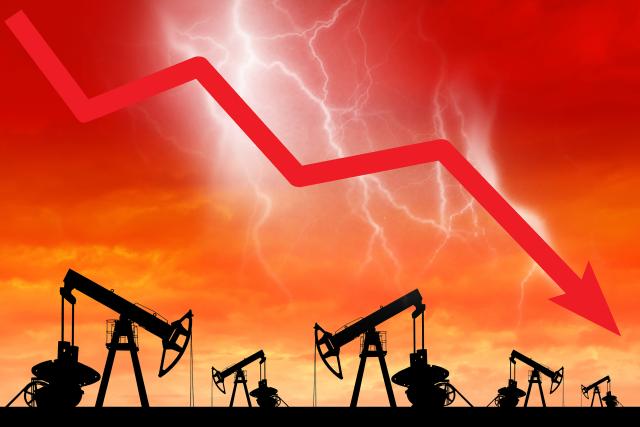
(Source: Shutterstock.com)
Vanishing energy demand as a result of the COVID-19 pandemic, a global price war and unprecedented oversupply has led to oil producers slashing their capex budgets by 36% this year and an expected drop in domestic production of nearly 2.5 million barrels per day (MMbbl/d), according to a recent analysis by IHS Markit.
“What we have is a situation in which we had an already oversupplied market and now we have a big demand shock,” Raoul LeBlanc, vice president of North American unconventional oil and gas market for IHS Markit, said during an April 2 webinar. “But in a lot of ways this downturn has some structural roots in that there has been a lot of global spare capacity that’s been building up over the last couple of years, and frankly, it has been built up to accommodate North America.
“In some ways, there are some chickens coming home to roost, but that has been compounded by the second disruption of the coronavirus,” LeBlanc said.
Despite the price war between Russia and Saudi Arabia that led to a surge in production, the main cause of the oil market collapse was a massive crash in demand, said Karim Fawaz, research director and energy advisor of financial and capital markets at IHS Markit. He compared the demand collapse to the peak of the 2008-2009 recession when global energy demand year-over-year contracted by 4 MMbbl/d.
“The scale of the demand collapse we are looking at here in the second quarter is in the 15-20 million barrel per day decline range, potentially north of 20 million barrels per day of decline in April,” he said. “So that’s five times larger in terms of a demand collapse during the worst of the financial crisis. So, the scale of this demand slowdown is something which we’ve never seen before.”
The result, Fawaz said, is an oversupply that could exceed 13 MMbbl/d over the span of a quarter. In 2015, with prices falling from $100/bbl oil, the market became oversupplied by about 2%, he noted, which led to a 60% drop in oil prices.
“We’re talking about an oversupply of 15% to 16% over the next few months,” Fawaz said. “We believe this is going to strain global storage capacity almost immediately. We’re going to be building inventories over the next few months to as close as possible to tank tops around the world at a velocity which we’ve never seen before.”
Going into this year, IHS projected overall capex will drop by 13%, which the company defined as “moderate” compared to 2019 capital expenditures. Those cuts were a result of operator efforts to balance production growth against free cash flow and leverage excess cash toward share buybacks or dividend increases. But with capital markets severely restricted to oil producers, it has become more expensive for companies to borrow, said Hassan Eltoire, director of companies and transaction research, for IHS Markit.
“Now we’ve seen capex cuts go from moderate to significant,” he said. “We expect now at least a 36% decline in total capex spending in 2020. These numbers will continue to increase as oil prices continue to fall. Instead of trying to balance production growth and free cash flow generation, what we’re seeing is companies move to capital preservation. What that means is dividend reduction and share buyback elimination. There is barely any excess cash out there, so they are not going to be giving it back to shareholders.”
He added that although about 42% of production this year is hedged into 2020, that amount might be “severely underestimated” since it does not include the latest capex cuts and production guidance announced by companies so far this year.
“Once they announce those, expect that 42% to move a lot higher,” he said. “But there is something that is even more important—even if companies can muddle through 2020—in 2021 there are no hedges in place. That means if oil prices stay low, we expect companies to go into deep financial strain. We expect more spending cuts, we expect companies to live within cash flow.”
Even pre-pandemic, and pre-price war, IHS estimated that U.S. oil production—which exited 2019 at 12.8 MMbbl/d—to grow by only about 500,000 bbl/d during the early part of the year and flatten out after about the first quarter and into 2021.
However, Reed Olmstead, director of upstream research at IHS Markit, said as a result of the existing market dynamics, domestic production will drop by 2.5 MMbbl/d this year and another 1 MMbbl/d in 2021, dropping total U.S. production to about 9 MMbbl/d by the end of next year.
While the current headwinds of a price war, global pandemic and massive oversupply are bearing down with full weight, there could be signs of a resurgence in the next few years. Olmstead explained that this year IHS estimated U.S. unconventional producers would spend $86 billion in capex, about $75 billion of which aimed to replace base declines from 2019 of 4.1 MMbbl/d.
“So that half million barrel per day of growth [estimated for 2020] came from $10 or $12 billion,” he said. “As we go forward, we see that that base declines shallow out, so in 2022 we only have to replace 1.7 million barrels. So, if we got a strong price signal, this beast comes unleashed again.”
Recommended Reading
EIG’s MidOcean Energy Acquires 20% interest in Peru LNG
2024-02-08 - On top of acquiring a 20% interest in Peru LNG, MidOcean Energy is also in the process of acquiring interests in four Australian LNG projects.
TotalEnergies Cements Oman Partnership with Marsa LNG Project
2024-04-22 - Marsa LNG is expected to start production by first quarter 2028 with TotalEnergies holding 80% interest in the project and Oman National Oil Co. holding 20%.
EIG’s MidOcean Closes Purchase of 20% Stake in Peru LNG
2024-04-23 - MidOcean Energy’s deal for SK Earthon’s Peru LNG follows a March deal to purchase Tokyo Gas’ LNG interests in Australia.
Which Haynesville E&Ps Might Bid for Tellurian’s Upstream Assets?
2024-02-12 - As Haynesville E&Ps look to add scale and get ahead of growing LNG export capacity, Tellurian’s Louisiana assets are expected to fetch strong competition, according to Energy Advisors Group.
MidOcean Completes Acquisition of Tokyo Gas’ LNG Interests in Australia
2024-03-31 - EIG’s MidOcean Energy will acquire Tokyo Gas’ interests in the Gorgon LNG, Pluto LNG and Queensland Curtis LNG projects.





